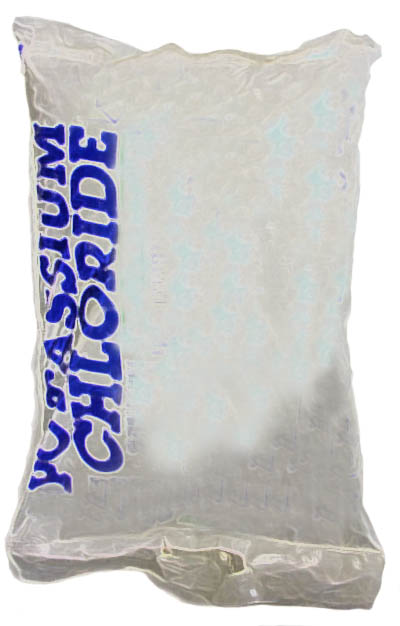Potassium Chloride Water Softener Salt

Hard water contains more minerals, especially calcium and magnesium, than ordinary water. This can lead to the buildup of scale in pipes and appliances. A water softener is used to reduce the concentration of these minerals.
In essence, a water softener consists of an ion exchange resin that removes the minerals as the water flows through it. After a while, the resin becomes saturated with these minerals and it no longer functions. At this point, a salt solution is added to the resin. The salt exchanges with the accumulated minerals, and allows them to be washed out of the softener into a drain. This rejuvenates the softener.
A variety of materials can be used as the water softener salt, e.g., sodium chloride (NaCl) or potassium chloride (KCl). In the example shown here, the water softener salt is over 99% potassium chloride.
All potassium contains potassium-40, a naturally occurring beta gamma emitter, and in large enough quantities it is easily detected with a simple survey meter. This bag, for example, could not get through a monitor at a nuclear power plant without setting off an alarm.
Potassium-40 (K-40) is a naturally-occurring radionuclide. Wherever there is potassium, there is potassium-40. If there is enough potassium, the K-40 can be detectable with a simple survey instrument.
Data
K-40 half-life: 1.28 x 109 years
K-40 decay mode:
- Beta decay (89.3%). The beta maximum energy is 1.31 MeV.
- Electron capture (10.7%)
- Gamma rays: 1461 keV (10.7%)
Daily intake of potassium element: 3.3 grams
Amount of potassium element in body: 140 grams (1.5 pCi/g or 55 Bq/kg of body weight)
Typical K-40 activity in body: 0.1 uCi. This means that there are over 200,000 atoms of K-40 that decay in the body each minute!
Typical K-40 activity in soil: 10 to 20 pCi/g
Dose from Potassium-40
The dose to a typical member of the population is approximately 15-20 mrem/year due to the K-40 in the body and 10 mrem/year due to the gamma rays emitted by K-40 in the environment (primarily the soil).
The human body maintains relatively tight homeostatic control over potassium levels. This means that the consumption of foods containing large amounts of potassium will not increase the body’s potassium content. As such, eating foods like bananas does not increase your annual radiation dose. If someone ingested potassium that had been enriched in K-40, that would be another story.
